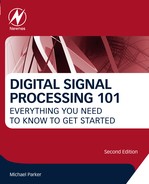Introduction
This book is intended for those who work in or provide components for industries that are made possible by digital signal processing, or DSP. Sample industries are wireless mobile phone and infrastructure equipment, broadcast and cable video, DSL modems, satellite communications, medical imaging, audio, radar, sonar, surveillance, electrical motor control—this list goes on. While the engineers who implement these systems must be very familiar with DSP, there are many others—executive and midlevel management, marketing, technical sales and field engineers, business development, and others—who can benefit from a basic knowledge of the fundamental principles of DSP.
Others who are a potential audience include those interested in studying or working in any of these areas. High-school seniors or undeclared college majors considering a future in the industries made possible by DSP technology may gain sufficient understanding that enables them to decide whether to continue further.
That, then, is the purpose of this book: to provide a basic tutorial on DSP. This topic seems to have a dearth of easy-to-read and understand explanations. Unlike most technical resources, this is a treatment in which mathematics is minimized and intuitive understanding maximized. This book attempts to explain many difficult concepts like sampling, aliasing, imaginary numbers, and frequency response using easy-to-understand examples. In addition, there is an overview of the DSP functions and implementation used in several DSP-intensive fields or applications, from error correction to CDMA mobile communication to airborne radar systems.
So this book is intended for those of you who, like me, are somewhat dismayed when presented with a blackboard (or whiteboard) full of equations as an explanation on DSP.
The intended readers include those who have absolutely no previous experience with DSP but are comfortable with high-school–level math skills. Many technical details have been deliberately left out, to emphasize just the key concepts. Although this book is not expected to be used as a university-course-level text, it can initiate readers prior to tackling a proper text on DSP. But it may also be all you need to talk intelligently to other people involved in a DSP-centric industry and understand many of the fundamental concepts.
To start with, just what is DSP? Well, DSP is performing operations on a digital signal of some sort and using a digital semiconductor device. Most commonly, multipliers and adders are used. If you can multiply and add, you can probably understand DSP. Actually, signal processing was around long before digital electronics. Examples of this are radios and TVs. Early tuners used analog circuits with variable capacitors to dial a station. Resistors, capacitors, and vacuum tubes were used to either attenuate or amplify different frequencies or to provide frequency shifting. These are examples of basic signal-processing applications. The signals were analog signals, and the circuits doing the processing were analog, as was the final output.
Today, most signal processing is performed digitally. The reason is that digital circuits have progressively become cheaper and faster, as well as due to the inherent advantages of repeatability, tolerance, and consistency that digital circuits enjoy compared to analog circuits.
If the signal is not in a digital form, then it must be first converted, or digitized. A device called an analog-to-digital converter (ADC) is used. If the output signal needs to be analog, then it is converted back using a digital-to-analog converter (DAC). Of course, many signals are already digitized and can be processed by digital circuits directly.
DSP is at the heart of a wide range of everyday devices in our lives, although many people are unaware of this. A few everyday examples are cellular phones, DSL modems, digital hearing aids, MRI and ultrasound equipment, audio equipment, set top boxes, flat-screen televisions, satellite communications, and DVD players.
As promised, the mathematics will be minimized, but it cannot be eliminated altogether. Some basic trigonometry and the use of complex numbers are unavoidable, so an early chapter is included to introduce these concepts, using as simple examples as possible. There is also one appendix section where very basic calculus is used, but this is not essential to the overall understanding.
..................Content has been hidden....................
You can't read the all page of ebook, please click here login for view all page.
